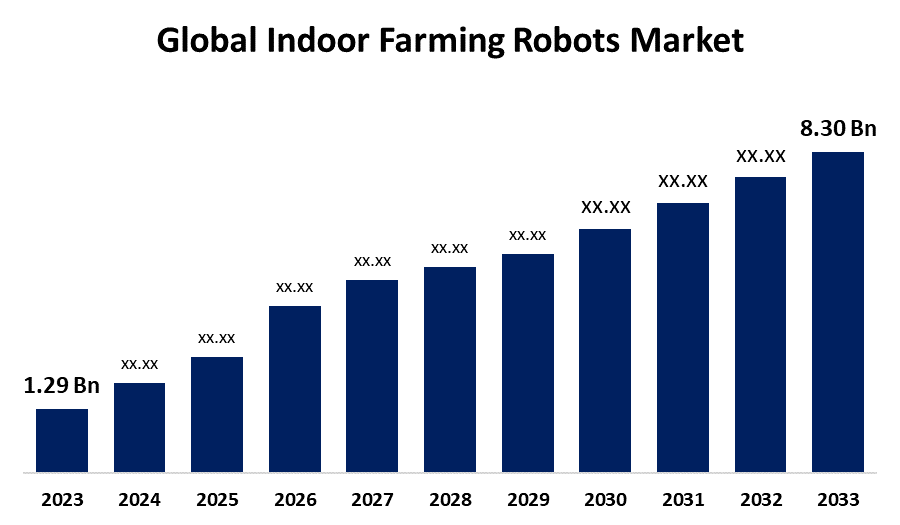Global Indoor Farming Robots Market Size, Share, and COVID-19 Impact, By Type (Harvesting Robots, Planting Robots, Weeding Robots, and Others), By Application (Vegetable Cultivation, Fruit Cultivation, and Others), By Technology (Artificial Intelligence, Machine Learning, IoT, and Others), By Region (North America, Europe, Asia-Pacific, Latin America, Middle East, and Africa), Analysis and Forecast 2023 - 2033.
Industry: AgricultureGlobal Indoor Farming Robots Market Insights Forecasts to 2033
- The Global Indoor Farming Robots Market Size was estimated at USD 1.29 Billion in 2023
- The Market Size is expected to Grow at a CAGR of around 20.46% from 2023 to 2033
- The Worldwide Indoor Farming Robots Market Size is Expected to Reach USD 8.30 Billion by 2033
- Asia Pacific is expected to Grow the fastest during the forecast period.

Get more details on this report -
The Global Indoor Farming Robots Market Size was worth around USD 1.29 Billion in 2023 and is predicted to grow to around USD 8.30 Billion by 2033, with a compound annual growth rate (CAGR) of 20.46% between 2023 and 2033. The market is driven by the growing interest in sustainable crop production and high demand to expand yield in the available space.
Market Overview
The indoor farming robots market refers to computerized robots that are capable of performing a range of farming tasks in controlled indoor conditions, such as greenhouses and vertical farms. Planting, irrigation, harvesting, and checking the health of plants are some of the operations performed by these robots, which utilize sophisticated technology like machine learning and AI. The growing demand for efficient and sustainable agricultural practices. With the world's population still on the rise, there is a need for more food production in limited areas. Indoor farming robots provide a solution as they maximize the use of resources, minimize waste, and maximize productivity. Increased consumer demand for fresh, locally-sourced, and pesticide-free produce is fueling the demand for indoor agriculture, and this provides a high-value market for robotic technology. Additionally, developments in AI, machine learning, and IoT are also creating new opportunities for innovation, allowing for the creation of more sophisticated and functional indoor agriculture robots. Moreover, governments and private organizations are understanding the potential of indoor farming for enhancing food security and promoting sustainable agriculture. Several initiatives and funding programs are being introduced to promote the research and adoption of intelligent farming technologies, such as robotics.
Report Coverage
This research report categorizes the Indoor farming robots market based on various segments and regions, forecasts revenue growth, and analyzes trends in each submarket. The report analyzes the key growth drivers, opportunities, and challenges influencing the Indoor farming robots Market. Recent market developments and competitive strategies such as expansion, type launch, development, partnership, merger, and acquisition have been included to draw the competitive landscape in the market. The report strategically identifies and profiles the key market players and analyzes their core competencies in each sub-segment of the Indoor farming robots market.
Global Indoor Farming Robots Market Report Coverage
| Report Coverage | Details |
|---|---|
| Base Year: | 2023 |
| Market Size in 2023 : | USD 1.29 Billion |
| Forecast Period: | 2023-2033 |
| Forecast Period CAGR 2023-2033 : | 20.46% |
| 2033 Value Projection: | USD 8.30 Billion |
| Historical Data for: | 2019-2022 |
| No. of Pages: | 230 |
| Tables, Charts & Figures: | 100 |
| Segments covered: | By Type (Harvesting Robots, Planting Robots, Weeding Robots, and Others), By Application (Vegetable Cultivation, Fruit Cultivation, and Others), By Technology (Artificial Intelligence, Machine Learning, IoT, and Others), By Region (North America, Europe, Asia-Pacific, Latin America, Middle East, and Africa) |
| Companies covered:: | Iron Ox, Bowery Farming, Plenty, AeroFarms, Spread Co., Ltd., Agrobot, Naio Technologies, Harvest Automation, Octinion, Root AI, FarmBot Inc., FFRobotics, LettUs Grow, and Others |
| Pitfalls & Challenges: | COVID-19 Impact, Challenges, Future, Growth, & Analysis |
Get more details on this report -
Driving Factors
The Indoor farming robots market is driven by growth the increasing need for efficient and sustainable agriculture operations is a key trend driving the indoor farming robots market. As the population of the world increases and urbanization expands, the need for more efficient food production systems has increased. Furthermore, indoor farming solves this by making it possible to produce food throughout the year in a controlled environment, thus greatly reducing the need for pesticides, water, and land. To combat climate change and hunger, governments and global organizations are putting more focus on sustainable agriculture. Moreover, the robots can work 24/7, greatly increasing productivity and lowering labor costs. For example, harvest robots can collect fruits and vegetables with very little human intervention, which ensures consistency and minimizes waste. Additionally, planting and weeding robots improve crop care by executing accurate work that is critical to the health and production of crops. The shortage of labor in the farming sector is another significant factor propelling the use of indoor farming robots.
Restraining Factors
The indoor farming robots market encounters certain difficulties that would restrain its development. The major constraints are the high up-front cost of investment in robotics technology and robotic systems. The long-term savings and benefits, although substantial, may be hindered by a large initial expense for small to medium-sized operations.
Market Segmentation
The indoor farming robots market share is classified into type, application, and technology.
- The harvesting robots segment held the largest share of the market in 2023 and is projected to grow at a substantial CAGR during the forecast period.
Based on type, the Indoor farming robots market is segmented into harvesting robots, planting robots, weeding robots, and others. Among these, the harvesting robots segment held the largest share of the market in 2023 and is projected to grow at a substantial CAGR during the forecast period. The segmental growth is due to their response to the tedious work of harvesting fruits and vegetables. They come equipped with sophisticated sensors and AI that allow them to spot ready-to-harvest produce, manipulate it delicately so that they do not get damaged, and harvest nonstop without rest. Furthermore, the use of harvesting robots is very prevalent in areas where labor shortages are rampant and there is a high cost of labor, including Europe and North America.
- The vegetable cultivation segment accounted for a significant share in 2023 and is anticipated to grow at a remarkable CAGR during the forecast period.
Based on application, the global Indoor farming robots market is divided into vegetable cultivation, fruit cultivation, and others. Among these, the vegetable cultivation segment accounted for a significant share in 2023 and is anticipated to grow at a remarkable CAGR during the forecast period. The growth is driven by the strong demand for fresh, locally-produced vegetables. Indoor farming makes it possible to produce vegetables like lettuce, spinach, and tomatoes throughout the year, regardless of weather conditions outside. Robots used for harvesting and planting are heavily utilized in vegetable farming to boost productivity and achieve uniform quality.
- The artificial intelligence segment accounted for the largest share in 2023 and is anticipated to grow at a remarkable CAGR during the forecast period.
Based on technology, the global indoor farming robots market is categorized into artificial intelligence, machine learning, IoT, and others. Among these, the artificial intelligence segment accounted for a significant share in 2023 and is anticipated to grow at a remarkable CAGR during the forecast period. The segment's growth is attributed mainly to the design and operation of indoor farm robots. AI programs allow robots to execute advanced functions like sensing when produce is ripe, disease detection, and maximizing planting designs. Additionally, AI technology evolves, its use in indoor farm robots will increase, providing even more advanced solutions for precision farming.
Regional Segment Analysis of the Indoor Farming Robots Market
- North America (U.S., Canada, Mexico)
- Europe (Germany, France, U.K., Italy, Spain, Rest of Europe)
- Asia-Pacific (China, Japan, India, Rest of APAC)
- South America (Brazil and the Rest of South America)
- The Middle East and Africa (UAE, South Africa, Rest of MEA)
North America is anticipated to hold the largest share of the Indoor farming robots market over the predicted timeframe.

Get more details on this report -
North America is anticipated to hold the largest share of the Indoor farming robots market over the predicted period. This dominance is due to the technological innovations and heavy investments in agritech. Moreover, the North American market is likely to sustain its strong growth, led by the rising demand for sustainable and efficient farming practices.
Asia-Pacific is expected to grow rapidly in the Indoor farming robots market during the forecast period. The market in the region is driven by the growing population density, urbanization, and government support for smart farming. Furthermore, China, Japan, and South Korea are leading the adoption of cutting-edge agricultural technologies, such as robotics.
Competitive Analysis:
The report offers an appropriate analysis of the key organization markets/companies involved within the Indoor farming robots market, along with a comparative evaluation primarily based on their type of offering, business overviews, geographic presence, business strategies, segment market share, and SWOT analysis. The report also provides an elaborate analysis focusing on the current news and developments of the companies, which includes type development, innovations, joint ventures, partnerships, mergers & acquisitions, strategic alliances, and others. This allows for the evaluation of the overall competition within the market.
List of Key Companies
- Iron Ox
- Bowery Farming
- Plenty
- AeroFarms
- Spread Co., Ltd.
- Agrobot
- Naio Technologies
- Harvest Automation
- Octinion
- Root AI
- FarmBot Inc.
- FFRobotics
- LettUs Grow
- Others
Key Target Audience
- Market Players
- Investors
- End-users
- Government Authorities
- Consulting And Research Firm
- Venture capitalists
- Value-Added Resellers (VARs)
Recent Development
- In February 2024, plenty, a vertical farming startup, introduced a new robots system to improve seeding and harvesting accuracy. The system’s indoor farming facilities are designed to boost yield while lowering operational expenses.
Market Segment
This study forecasts revenue at the global, regional, and country levels from 2023 to 2033. Spherical Insights has segmented the Indoor farming robots market based on the below-mentioned:
Global Indoor Farming Robots Market, By Type
- Harvesting Robots
- Planting Robots
- Weeding Robots
- Others
Global Indoor Farming Robots Market, By Application
- Vegetable Cultivation
- Fruit Cultivation
- Others
Global Indoor Farming Robots Market, By Technology
- Artificial Intelligence
- Machine Learning
- IoT
- Others
Global Indoor Farming Robots Market, By Regional Analysis
- North America
- US
- Canada
- Mexico
- Europe
- Germany
- UK
- France
- Italy
- Spain
- Russia
- Rest of Europe
- Asia Pacific
- China
- Japan
- India
- South Korea
- Australia
- Rest of Asia Pacific
- South America
- Brazil
- Argentina
- Rest of South America
- Middle East & Africa
- UAE
- Saudi Arabia
- Qatar
- South Africa
- Rest of the Middle East & Africa
Frequently Asked Questions (FAQ)
-
1. What is the CAGR of the Indoor farming robots market over the forecast period?The global Indoor farming robots market is projected to expand at a CAGR of 20.46% during the forecast period.
-
2. What is the market size of the Indoor farming robots market?The global Indoor farming robots market size is expected to grow from USD 1.29 billion in 2023 to USD 8.30 billion by 2033, at a CAGR of 20.46% during the forecast period 2023-2033.
Need help to buy this report?